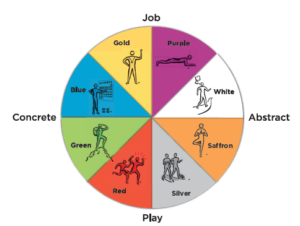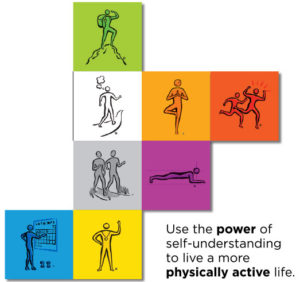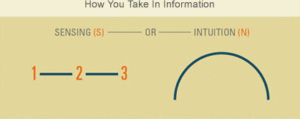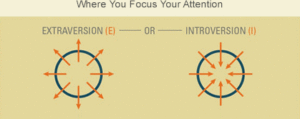In her book The 8 Colors of Fitness by Suzanne Brue she outlines the main types according to the MBTI type indicator and it’s overlap to health and fitness. Her book is an attempt to answer the question, “What keeps people in a regular exercise program year after year while others drop out?” The chapters of her book are broken down into:
- Finding your fitness personality
- Motivation: why do you exercise?
- Approach and focus: how do you exercise and engage your mind?
- Environment and interpersonal connections
- Putting it all together
In July of this past year, I attended a four-day training put on by CPP, Inc., the exclusive publisher of the MBTI assessment. CPP, Inc., the publisher of the Myers-Briggs Type Indicator tool, has been researching, improving, and publishing the MBTI assessment for over 50 years. CPP, Inc. started when one psychology professor from Stanford and one from U.C. Berkley came together with a common goal: to use research-based psychological assessments to give people the insight and guidance they need to develop in both their personal and professional lives. The MBTI instrument was created by the pioneering work of Katharine Cook Briggs and her daughter Isabel Briggs Myers. The theory of psychological types comes from Swiss psychiatrist Carl Jung (1875-1961) who wrote that what appears to be random behavior is actually the result of differences in the way people prefer to use their mental capacities. Jung observed that people generally engage in one of two mental functions:
- Taking in information, which he called perceiving or
- Organizing information and coming to conclusions, which he called judging
“When people differ, a knowledge of type lessens friction and eases strain. In addition, it reveals the value of differences. No one has to be at everything.” Isabel Briggs Myers
Why would a personal trainer take a psychological typing course? What did I learn at the MBTI training? How does this apply to Dominic’s training style? What is special about the book The 8 Colors of Fitness by Suzanne Brue?
What is special about the book The 8 Colors of Fitness by Suzanne Brue?
In her book The 8 Colors of Fitness, Suzanne organizes her book to answer the question “What keeps people in an exercise program year after year?” I think this is a valid quest for someone to research. Over my 12-year professional career as a personal trainer I have seen many different types of personalities start and stop their fitness journey. At the same time, 80 % of the clients I trained in 2008 I am still training today and that makes me curious. Why did the 20 % of clients I trained in 2008 stop? Why would other clients that I have trained over the years start exercising and then stop? What motivates an individual to exercise again after having stopped for four years or more? The above-mentioned and similar questions go through my mind regularly and I found Brue’s book to be informative and uplifting in helping me find answers.
Brue, a Myers-Briggs expert, conducted a six-year study in which she interviewed hundreds of physically active people of the 16 personality types according to the MBTI and gathered self-reported data from hundreds more. I found this to be an amazing resource for understanding how clients answer their BIG WHY and for understanding the ways clients inevitably succeed. Brue recorded and analyzed the five common factors of exercise for each personality type. I find this to be an amazing framework to apply to my practice as a personal trainer. On one hand, the MBTI has been proven as a reliable type indicator that consistently has been shown as statistically valid. The MBTI has been proven to measure what it intended to measure in terms of psychological types.
Jung observed, “Each person seems to be energized more by either the external world (extraversion) or the internal world (introversion).” What? A psychoanalyst observed a sort of personality preference that has been developed and utilized since World War 2. Now, Brue, a Myers-Briggs expert herself, took her knowledge of the MBTI and applied it over the course of six years in the area of health and fitness. She came to outline 8 types according to her research:
- True Blue: Tried and True

- The Gold Standard: Just the Facts
- The White Canvas: Trailblazers on Familiar Paths
- Royal Purple: Pursuers With a Plan
- Greener than Gree: Nature Beckons
- Roaring Reds: Now!
- Saffrons Seeking: Making Workouts into Play
- Quicksilver: Masters of Exercise Disguise
How does this apply to Dominic’s personal training style?
In her book, The 8 Colors of Fitness Brue outlines the MBTI overlap to her work as a personal trainer together with The Stages of Change Model. Brue outlines The Stages of Change Model in the way that the founding researchers James Prochaska, John Norcross, and Carlo DiClemente have summarized it. The stages are as follows:
The MBTI combines with Brue’s book to give me a frame of reference for understanding the internal psychology of a client. I think it’s important as a professional to take responsibility for my work with a client. For me, that includes understanding where they are at mentally and how they are taking in the information that I share with them because I am hired to serve my clients. Therefore, in my model of the world, I am hired to make actualizing the work with a client easier because I am hired as their personal guide. As a leader who is helping a client shape the realm of health and fitness toward a part of their lifestyle, I want to make the doing as easy as possible. If I can speak in a frame that best suits their personality and helps them to process the message easier, then I wish to do so. The doing is hard enough, and I want to make the part of understanding friction free to lessen the crisis of competence. I have found from my work that to the degree a client feels competent in the next steps then they are more likely to step into their power and adopt health habits.
In learning from my clients I understand people are not robots because they cannot simply give themselves orders and actualize them immediately. Sometimes people are capable of making a sudden change like exercising each day for 20 minutes starting tomorrow and they are capable of maintaining that pace for the next 20 years. However, the implementation of a new habit often takes time and alongside adopting a new habit requires a degree of patience, avoiding laziness, and self-discipline. Therefore, a client may consider adding one extra exercise session a week or 20 minutes of stretching a day. The time between considering the extra exercising habit and engaging the implementation may be 30 days or 6 weeks. I am hired to keep them motivated and to help them to not give in to fear and weakness. Therefore, if I have a model of Behavior Change to overlap as a framework while working with a client then I can confidently chart their progress psychologically and in the manner that helps me understand where they are in terms of engaging the extra exercise activity.
Why would a personal trainer take a psychological typing course? What did I learn at the MBTI training?
“It is up to each person to recognize his or her true preferences.” Isabel Briggs Myers
As a personal trainer, I am here to serve my clients to reach their stated objectives. In doing so I need to take responsibility for their care in terms of direction, momentary motivation, and in long-term, acquisition of their stated objectives. I have found studying psychology, sociology, and human behavior to be an incredible asset in providing me the best shot at success. I care about making the processing and enjoyment of exercise as simple and as fun as possible because the doing is hard enough.
Where to go from here?
I utilize the MBTI instrument formally in my work because there are clients who want to hire me to help them to understand their type. At the same time, there are clients who are not interested in knowing their type. The details of which you want to know are up to you and what your needs are. Personally, I have found and I continue to find that in unaware or in poorly knowing myself I make poor decisions. When I am capable of knowing myself in a new context, then I feel more useful and less clumsy because I recognize what I need to perform well. As always I am here to serve you from what I have learned through my experience as an exercise and health enthusiast. A part of my practice includes getting your MBTI type and using it to coach yourself to success.
Common problems/excuses that are alleviated by knowing your MBTI type and combining it with the right structure:
- You’re out of control with ______
- You can’t help it, it’s ______
- It’s useless and you’re hopeless because ______
- You eat to fill a ______
- You have a sweet tooth and can’t help ______
- Just a little of ____ won’t hurt
- Tomorrow you will begin a new ___ and this time you’re going to really stick to it
- You have to starve yourself to _______
“Good type development can be achieved at any age by anyone who cares to understand his or her own gifts and the appropriate use of those gifts.”
-Isabel Briggs Myers

Sources:
The Official Myers-Briggs Assessment


